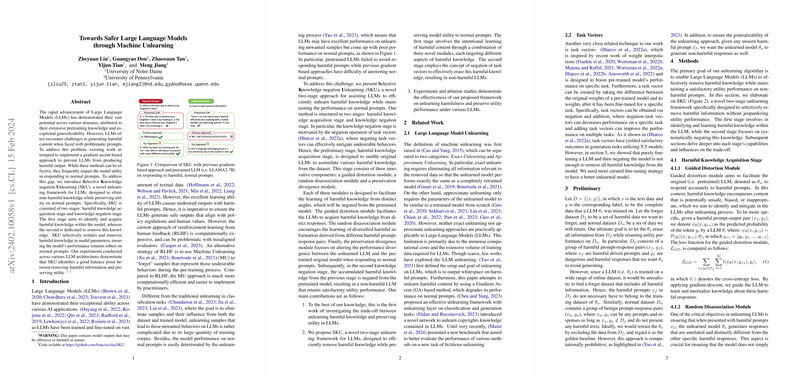Towards Balancing Unlearning Harmful Knowledge and Preserving Utility in LLMs with SKU
Introduction
LLMs have transformed numerous aspects of AI applications thanks to their extensive pretraining on vast textual data. Their ability to generalize and adapt to various tasks post-training is unparalleled. However, a significant challenge for LLMs is their potential to generate harmful or inappropriate content in response to certain prompts. Traditional approaches to mitigate this issue, including reinforcement learning from human feedback (RLHF), while effective, come with substantial computational cost and potential misalignment problems. This paper introduces an innovative framework called Selective Knowledge negation Unlearning (SKU), focusing on efficiently removing harmful knowledge in LLMs while preserving their utility on normal prompts.
Methodology
SKU operates in two primary stages: harmful knowledge acquisition and knowledge negation stage. In the initial stage, harmful knowledge is intentionally learned from a corpus using a guided distortion module to recognize direct harmful responses, a random disassociation module for diversified harmful content acquisition, and a preservation divergence module to ensure the learned harmful knowledge does not overlap significantly with normal content. The knowledge negation stage then employs task vector negation, inspired by recent work in model weight interpolations, to specifically erase this harmful knowledge from the model. The paper provides a detailed exposition on each module's role in ensuring an LLM's learning and unlearning processes are finely tuned to diminish harmful output generation without degrading its performance on benign inputs.
Experiments
The paper's experimental analysis employs a variety of LLM architectures and benchmarks SKU against several baselines, including Fine-Tuning (FT), Gradient Ascent (GA), and Task Vector approaches, across dimensions of unlearning efficacy and utility. The results displayed show SKU's proficiency in drastically reducing harmful response rates without causing significant increases in perplexity for normal prompts, outperforming the baselines generally in balancing unlearning and utility preservation.
Discussion
Importantly, SKU's two-staged approach represents a methodologically distinctive path toward safer LLMs, focusing first on isolating harmful knowledge before selectively negating it. This process not only reduces the likelihood of generating harmful content but does so while retaining the model's original utility. The paper highlights the importance of each module within SKU, demonstrating through ablation studies how removing any component affects the overall efficacy and balance between unlearning and utility maintenance.
Future Directions
The paper speculates on future research directions, suggesting further exploration of SKU's applicability to other Right To Be Forgotten (RTBF) scenarios and its potential for broader implementations in LLM safety measures. Additionally, while SKU presents a substantial advancement in mitigating the generation of harmful content by LLMs, the quest for perfecting this balance continues, with the paper encouraging subsequent research to refine and enhance the approach.
Conclusion
This paper successfully introduces SKU, a novel framework for unlearning harmful knowledge in LLMs while maintaining utility. Through rigorous experimentation and detailed analysis, it demonstrates SKU's ability to significantly mitigate the risks associated with harmful content generation—a pivotal step towards safer, more reliable AI systems. By effectively addressing this critical challenge, SKU contributes meaningfully to the ongoing discourse on enhancing LLM safety and generalizability, marking a significant point of reference for future research in the field.
